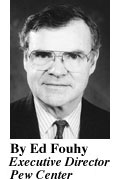Winter 1997
Foundations: Nurturing Journalistic Values or Threatening Independence?
 The latest
The latest
directory of the Association for Education in Journalism and
Mass Communications lists no fewer than 26 foundations that
nurture journalism. The programs range from year-long
continuing education programs at first-rate universities to
weekend workshops on specific issues to an examination of the
bedrock values that define journalism. And the role of
foundations in journalism seems to be increasing across the
board.
All of this underlines what we at the Pew
Center have been heartened to learn in our three years of
operations– how many allies we have in our work to improve
the journalism-audience connection. Does all of this
foundation activity constitute a threat to the independence
of newspapers and broadcasters? Independence is, after all, a
core value of journalism, respected by all journalists worthy
of the name, and as former editors we are deeply sensitive to
the issue.
Last fall The Wall Street Journal
set out to explore the question of whether The Pew Charitable
Trusts were buying their way into newsrooms. If the newspaper
found any evidence to support that view, it wasn’t shared
with readers nor were any editors quoted who seemed alarmed
by foundation funding of newsroom projects.
Perhaps that’s because of the special role
foundation funding plays in our economy. It is the financial
underpinning for high-risk experiments that cannot attract
capital from conventional sources. It is different from
conventional capital because foundations do not demand a
financial return on their investment.
Foundation funding is seed money, targeted
where there is a chance for a break-out idea to find its
legs, but, for which, for whatever reason, conventional funds
aren’t available. We operate in the hope that if a civic
journalism project proves itself, its parent news
organization will take over support and incorporate the
lessons learned into daily operations.
That is, indeed, what seems to be happening
as newsrooms that earlier sought support now find ways to
incorporate civic journalism principles into the way they
cover the news. This and other issues of the Civic
Catalyst are filled with reports from forward thinking
editors on projects we have encouraged around the country.
Pew’s Venture Funding
Although each foundation has its own
approach, here is how the venture capital selection system
works at the Pew Center: An applicant proposes a worthy idea
that conforms to our guidelines, the proposal is accepted for
consideration, our advisory board meets, selects and approves
the initiatives to be supported. A subcontract is signed and
a check sent to start the project down a road that the
editor, not us, has chosen.
That completes the transaction except for a
final report when the project ends.
No one looks over the editor’s shoulder, no
one visits the newsroom unless invited, there is no demand
that reporters attend our workshops, screen our videos or
even read our publications. Oh sure, we like to see
tearsheets and are happy to report on projects so the rest of
the profession can share the lessons the editor has learned,
but that’s the extent of our involvement.
We’ve learned that early seed money is
essential to help with the initial unbudgeted expenses of
launching a civic journalism initiative. The most common use
of Pew money is to fund survey research or to hire a
community coordinator who knows how to reach out to the
community.Staffing and news hole are two areas where our
funds may not be used; other than that, where the money is
spent is left to the creativity of local journalists.
Foundations in Journalism
In addition to our work and the well known
fellowship programs for mid-career journalists at Harvard,
Michigan and Stanford, all funded by foundations, other
examples abound of the imaginative use of foundation funds to
foster good journalism.
The McCormick-Tribune Foundation underwrites
"News in the Next Century," an exploration of how
new technology will affect the electronic news media. A
separate effort, "New Directions for News," seeks
to bring innovative thinking to bear on newspapers’ changing
readership. Still another grant supports the Values
Institute, an initiative of the American Society of Newspaper
Editors, which is wrestling with the question of what
journalistic values will guide newspapers as they face new
competition. Altogether, these are multi-million dollar
programs designed to help guide a multi-billion dollar
industry buffeted by changing technology as it moves into
largely uncharted waters.
The Freedom Forum is picking up the tab for
reporter Lisa Herzing Burgess’ year-long stint as a fellow at
the National War College. This new program is designed to
give journalists reporting on defense policy a more
sophisticated grasp of the nation’s weapons and strategy and
to narrow the gap of misunderstanding between the military
and the media.
The Joyce Foundation helped fund the Center
for Public Integrity’s tracking of campaign contributions,
widely used by news organizations covering the 1996
elections. The Center did basic reporting and analysis that
few news organizations could have undertaken on their own,
now that downsizing has left most journalists panting from
deadline to deadline.
The reason foundations are involved with
journalism is that journalism isn’t just another business.
While profit obviously motivates every business enterprise,
journalism is the only one that provides news and
information–the oxygen democracy and its companion, free
enterprise, need to survive.
The question is: Will the drive for
ever-higher profits collide with the need to incubate the
civic journalism techniques some news organizations are
developing to hold onto their readers and viewers in the face
of growing competition from other news sources.
Foundation funding is a meager substitute for
the dollars that owners and publishers ought to be spending
to develop better educated people, stronger news values and
innovative journalism techniques. However, until the big
media companies come to that realization on their own,
foundations will be there to help.
